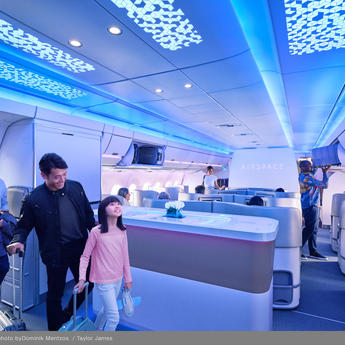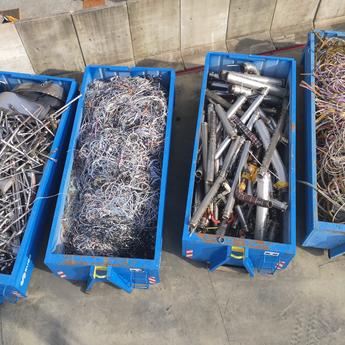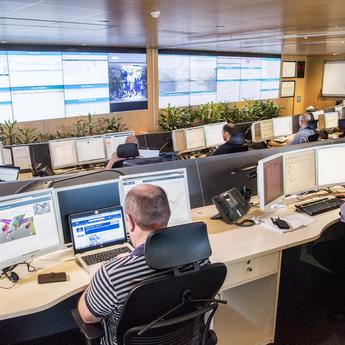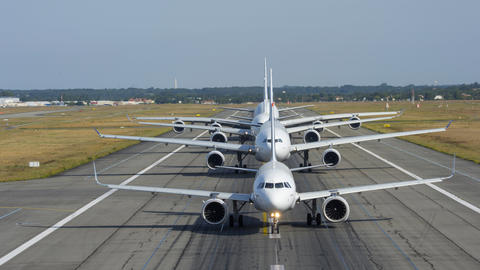Pilots and ground staff rely on the cockpit SATCOM as an essential means to communicate. Evolving user requirements and technology have led Airbus to review and update the system.
Today, satellite constellation technology enables more throughput, taking into account regulation requirements and the growing number of customers. However, whilst airlines need and expect more connected IP-based applications, it is fundamental to ensure aircraft systems remain protected.
The Light Cockpit SATCOM (LCS) provides a solution, using IP technology as well as stringent data security barriers in accordance with regulations.
Since the early stages of commercial aviation, and in order to enhance safety, regulations have required long-range communication means for flying over oceanic and remote areas. Initially performed exclusively with HF voice communication, the cockpit SATCOM which operates in the L-band radio frequency is now recognized as an alternative means of communication with the ATC (Air Traffic Control) or AOC (Airline Operation Centre). For continental areas such as Europe, VHF is mainly used thanks to a widely deployed, but increasingly congested, VHF ground network.
Note: cabin SATCOM operates in Ku/Ka band radio frequency.
Typically, thanks to the EFB (Electronic Flight Bag) live weather forecast application, the crew on a transatlantic flight can detect an unexpected approaching storm cell with potential turbulence as a complement to the onboard weather radar. They can then call the ATC using the satellite communication system to get clearance to change the flight plan.
The crew can also use the SATCOM to contact the AOC regarding, for example, an HF system fault message alert during the flight which could impact the next flight dispatch. This enables maintenance teams to be ready to check the fault on arrival and minimise delay.
LEGACY: VHF antenna on left and SATCOM on right
NEW: VHF antenna on left and new Light Cockpit SATCOM (LCS) on right
Ten ways to increase performance and efficiency
Operators equipped with the new Inmarsat LCS - in place of the previous-generation one - will gain:
- more protection against cyber attacks
thanks to state-of-the-art data security mechanisms associated to IP technology introduction; - faster cockpit connectivity
with up to 200 kbps (compared to 30 kbps provided by previous generation); - EFB internet (IP) connectivity for flight crew
enabling uploading of live weather updates and in-flight briefing updates (requires FOMAX communication router option).
As an example, NAVBLUE proposes an Electronic Flight Assistant Mission+ that will take advantage of the full LCS capabilities. On previous generations, ACARS network was used (capable of 30 kpbs). - optimised communication costs
by rerouting part of the ACARS traffic over the LCS IP communication channel (FOMAX required).
And the new design means operators will benefit from:
- lighter weight - with up to 50kg of weight reduction compared to previous generations;
- limited drag, thanks to the low profile antenna;
- lower power consumption - 5 to 6 times less than current SATCOMs;
- lower maintenance costs, with less equipment as the ELGA antenna integrates a DLNA (Diplexer & Low Noise Amplifier) and a Power Amplifier;
- an easier, data-loadable system as the unit does not need removing from the aircraft FLS (Field Loadable Software). FLS is retrievable from the AirbusWorld customer portal thanks to the dematerialisation initiative (no more physical media);
- a common linefit and retrofit solution for the A320, A330 and A350 families. There are also provisions on A320 to allow a later retrofit installation - to address lessors’ configuration needs, for example.
Airbus Customer Support will become the primary interface for operators, instead of going via the supplier, resulting in quicker outage resolution. Airbus will coordinate with all other parties (including the supplier) as required.
LCS simplified system
The new cockpit SATCOM is lighter and brings increased performance, but with a much simpler system composed of:
- A computer (SDU), located in the avionic bay, managing all SATCOM functions (operational and maintenance) and ensuring interface with avionics.
- A configuration module (SCM / SDU Configuration Module) embedding SIM card, certificates for secured communication with the ground, configuration of the system and the phone directory.
- A new generation compact / low profile antenna ensuring communication with satellites integrating also power amplifier, filters and splitters (ELGA).
- A single coaxial cable between SDU and Antenna handling power supply, radiofrequency signals, antenna monitoring data and antenna software loading.
How to operate LCS
Flight crew can operate and control LCS with the new radio control means RMP (Radio Management Panel, cf FAST article Cockpit communication - new-generation audio system) or with the legacy MCDU (Multipurpose Control and Display Unit) and ACP (Audio Control Panel), according to aircraft configuration.
LCS flight crew training remains the same as legacy SATCOM implementations.
To operate LCS, airlines need to subscribe to a new service contract with usual Communication Service Providers (CSP), the same actors as for current cockpit SATCOMs.
Data security protection
As LCS is introducing IP connectivity, security architecture functions & mechanisms are embedded in order to protect the aircraft against cyber attacks:
- Physical and logical segregation between each aircraft domain ACD (Aircraft Control Domain / safety cockpit communication), AISD (Aircraft Information Services Domain / non-safety cockpit communication);
- Guaranteed Integrity of safety communication (ACD);
- A shared security barrier (on aircraft and on ground gateway), based on PKI (Public Key Infrastructure) mutual authentication and VPN (Virtual Private Network) tunnel, is implemented to complement the ground security barrier managed by the satellite service provider;
- Filtering communication coming from the ground via Firewall.
The LCS flight test campaign
During the development phase of the LCS, flight tests were conducted on several Airbus aircraft types. More than 70 hours of dedicated flight were performed. The objective was mainly to check the correct behaviour of the SATCOM interconnected to the avionics, ensure there was no interference with other Communication/Navigation/Surveillance systems, evaluate the end-to-end connectivity performance through satellite space and also the ground segment during all phases of flight and all flight envelope of the aircraft. Flight crew workload and Human Machine interface were also evaluated.
Jim FAWCETT, Lead Flight Test Engineer and specialist in communications systems describes the experience: “We operated our flight test aircraft throughout the whole of the flight domain to ensure good SATCOM coverage even in case of manoeuvring. To ensure good geographical coverage and correct voice and data service behaviour at satellite handover boundaries, we even operated our A350 on a 12-hour flight from Toulouse in France to Gander in Canada and back, without landing! Our crews found the HMI (Human Machine Interface) intuitive and easy to use. The system behaved well and should provide a secure solution for our customers in the years ahead.
LCS and regulations
This new system is compliant with the following regulations:
- CAAC AOC voice communications connection within 4 mn requirement
- RCP240 and RSP180 for North Atlantic, South Pacific and Y1, Y2, Y3, & L888 routes in China
- FANS 1/A
- AC 20-150B - Airworthiness Approval of Satellite Voice (SATVOICE) Equipment supporting Air Traffic Service Communication
- Aircraft normal tracking ICAO recommendation through AOC
- LCS Inmarsat has been designed to be compliant with up-to-date EUROCAE and ARINC standards
Understanding end-to-end satellite communication
SATCOM enables aircraft to exchange information with ground end users, typically ATC and AOC. Communication can be done either by voice or datalink means using IP network layer communication protocol.
Exchanges with ATC are essential to prevent collisions, ensure and optimize the traffic in controlled airspace. Aircraft automatically report their position (ADS-C) and also exchange data via pre-formatted messages (CPDLC) to allow controllers to safely guide aircraft to their destination (routine operations). Both functions are part of FANS application (FANS 1/A in oceanic and remote areas). Flight crew can contact or be contacted by ground control by voice means (SATVOICE function) in distress, emergency or flight safety situations (non-routine operation). Such communication exchanges supporting safe operation of aircraft are part of the “Aircraft Control Domain”(ACD). These critical communications must demonstrate minimum end-to-end performance known as PBCS (Performance-Based Communication and Surveillance). PBCS defines a minimum performance to allow an aircraft to use optimized routes (therefore allowing fuel savings).
Exchanges with AOC allow airlines to support aircraft operational efficiency. It is part of Airline Information Services Domain (AISD). Aircraft can receive and send preformatted automatic maintenance reports via the ACARS network. To support flight operations, crews can request weather data updates during flight to optimize flight path while ensuring passenger comfort (cf FAST article EFB - the new standard). Aircraft also send maintenance reports to the ground automatically, in order to anticipate dispatch and maintenance activities after landing. Voice calls offer also the possibility for pilots to exchange operational information complementary to ACARS with their airline control centers.
Passenger Information and Entertainment Services Domain (PIESD) encompasses all passenger services, mostly known as IFE (In-Flight Entertainment) and includes video streaming, passenger internet and intranet browsing, access to social media... This domain is today handled by cabin SATCOM (average throughput 20/30 Mbps) but cockpit SATCOM with cabin capability can fulfil it (throughput <1 Mbps) for basic need and/or as a backup for cabin SATCOM means.
All cockpit communications to/from aircraft are routed through Satellite Service Providers (SSP) infrastructures (Satellite, Gateway/GES). Today two SSP are recognised to be used by commercial aviation to exchange aircraft cockpit data with ground users: Inmarsat and Iridium.
Then depending on the communication domain they are routed from SSP gateways to ground end users in the following way:
- via Communication Service Providers (CSP) to end users Air Traffic Control (ACD) or Airline Operation Centers (AISD) that relay communications in a secure way while ensuring performance. Two CSP are today recognised to be used by Commercial aviation to exchange Aircraft Cockpit data with ground users ATC/AOC : Collins Aerospace (formerly ARINC) and SITA
- directly to the Internet network for PIESD.
The LCS relies on the Inmarsat L-Band satellite constellation (today ensured by four I-4 satellites, to be complemented and superseded tomorrow by I-6 ELERA satellites network operating in geostationary orbit) using SB-Safety 2.0 services.
Inmarsat site https://www.inmarsat.com/en/solutions-services/aviation/services/sb-s.html
Next steps
The next Inmarsat LCS evolution under development is FANS C over SATCOM (FAST article FANS C - on page 34). This future capability will enable the use of SATCOM for ATC datalink communications over ATN (Aeronautical Telecommunication Network). It will provide an alternate means to alleviate the European VHF datalink network, expected to be saturated in the near future, especially in high density areas, mitigating the risks of quality degradation of datalink services for ATC and AOC. FANS C over SATCOM will enter into service on A320 and A330 aircraft families and will be capable of 4D Trajectory Based Operations (new mandate from 2028).
The LCS proposes a light and efficient SATCOM solution. Beyond standard SATCOM voice and datalink usage, the LCS will unlock the use of new connected applications such as Mission+ from NAVBLUE (an Airbus subsidiary). Airlines will have new means to optimize their operations.
It provides a high data security level, with reduced maintenance costs and power consumption. It is designed for easy upgrades.
Operators started flying with the LCS at the end of 2021 on both A330 and A320 Family aircraft. It is now offerable to airlines for the A350, with entry into service planned in 2023.
Glossary
- ACARS: Aircraft Communications Addressing and Reporting System
- ADS-C: Automatic Dependant Surveillance - Contract
- CAAC: Civil Aviation Administration of China
- CPDLC: Controller Pilot Datalink Communication
- ELGA: Enhanced Low Gain Antenna
- FANS: Future Air Navigation System
- FOMAX: Flight Operations and Maintenance Exchanger
- GES: Ground Earth Station
- HF: High Frequency
- HPA: High Power Amplifier
- ICAO: International Civil Aviation Organization
- IP: Internet Protocol
- MCU: Modular Concept Unit
- RCP: Required Communications Performance
- RSP: Required Surveillance Performance
- SATCOM: Satellite Communication
- SSP: Satellite Service Provider
- VHF: Very High Frequency
Photo copyright Airbus. Photo credits: S. Ramadier; P. Pigeyre & A. Doumenjou for Master Films.
Your media contacts
Contact us
Guillaume de Bony de Lavergne
Cockpit SATCOM Work Package Leader - Airbus
Rui Fernandes Dos Santos
Datalink and Communication Systems Specialist - Airbus
Latest FAST articles
Continue Reading

Getting ready for A350 cabin retrofits
Web Story
FAST
The first A350s are reaching eight years in service, and the wave of cabin retrofits which is now starting will rapidly gain momentum over the next few yea
Turbulence alert - The collaborative network
Web Story
FAST
Intermittent repetitive failure
Web Story
FAST

End-of-life Reusing, recycling, rethinking
Web Story
FAST

In-flight health monitoring
Web Story
FAST

